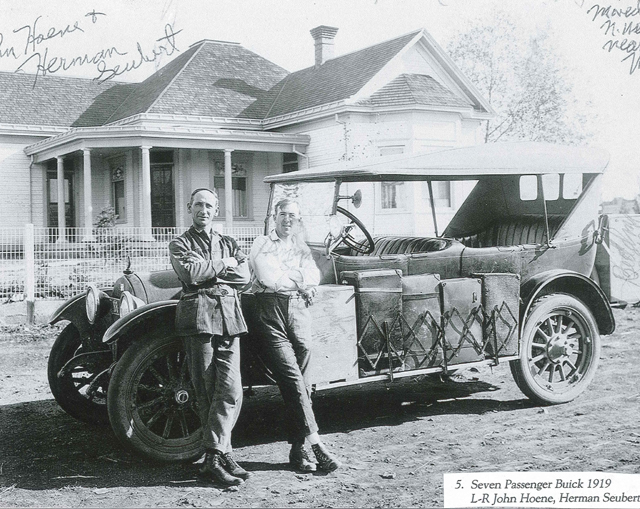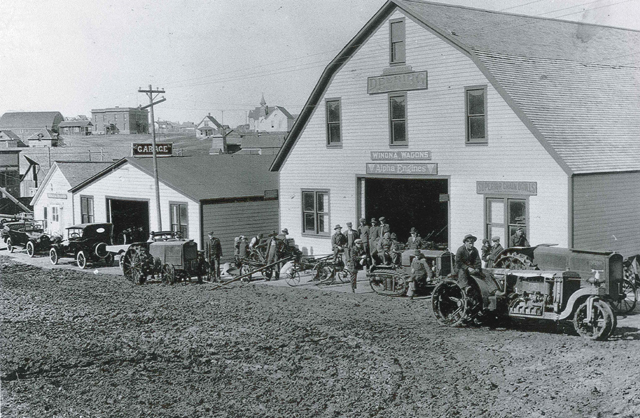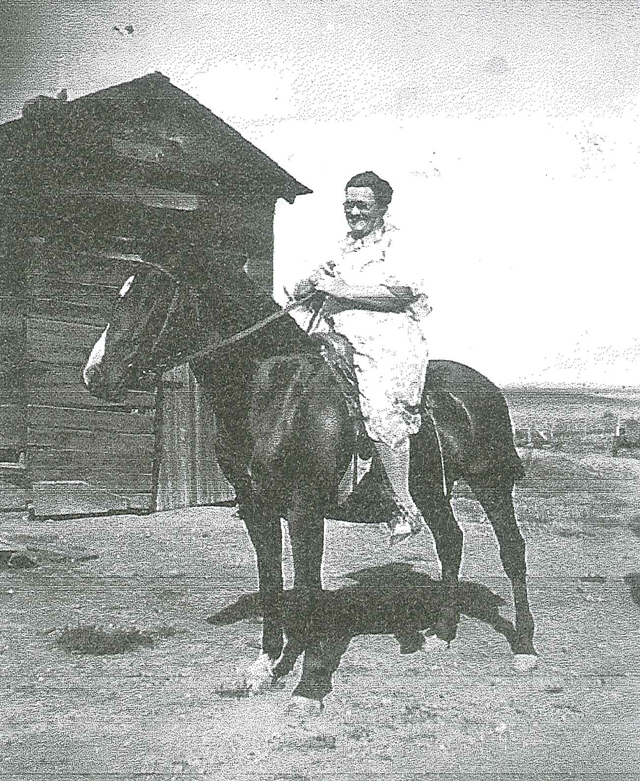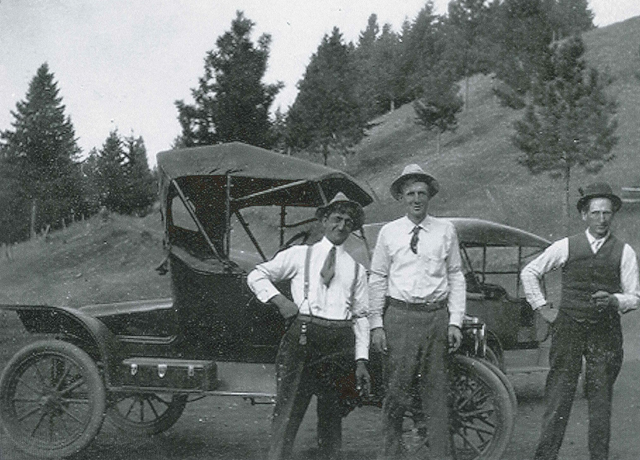| Cottonwood
to celebrate 150th year in 2012, area history included
(History continued from last week) Haying is now in full swing in almost the whole area. The crop is good and promises to fill the hay shed. The crops for harvest look to be from good to excellent. Oh yes, the ladies and their flower beds also are showing up pretty as usual. The rain the last few months shows up in the size and beauty of all the flowers. We also have some real nice garden showing beans, born, potatoes and many other lush looking things to eat. I like to think this is another thing passed all the way from 150 years ago. It used to be from necessity these great gardens came. Now we find both men and women still producing stuff for cellar and freezer and for the 3rd and 4th generation in the same garden spot used by Great Grandma and Grandpa. I’m sure many happy memories come with this labor of love. In the nearby streams and rivers the water is backing off and reports of moderate fishing, mostly with bait, are being told. Also we are hearing about the snow slowly retreating in the higher mountains but some roads are still blocked waiting for the snow to melt. Come the last week in July the road will be filled with the “trailer people” (on the road again!) Once again, this great area has so much to offer both the visitors and the people who live here. And, as we have been recalling, the people who now live here have, in their inheritance, really added to the area’s natural beauty with their stories and keeping up the family traditions. Many families have passed down their skills from one generation to another for now three and four generations. These skills, like teaching farming, lumbering and many forms of business seem only natural to those who follow in grandpa’s footsteps. We now, in our hospitals have these people following in medical care and the treatment of the sick. These people follow in the footsteps do so, not because they were forced to, but rather out of pride and respect and a way to show their honor for other members who led them on this pathway. This mark of pride and appreciation shows up in almost every family now calling this area their “Home.” Just look about you in your own family – how many have followed in mom’s or grandma’s abilities – things in and around the house like cooking, sewing, gardening, music and most of all family rearing, love and pride! All these traits of mom and dad we used to look at differently, but now see the important role they play in all our lives. Like the old saying “Mom and Dad sure have gotten a lot smarter than they used to be!” Each generation has developed their own way of “looking back.” And, as always, we find a special love and respect in our hearts for most all our family trees. We sometimes wait too long before passing the stories of “kith and kin” on to our children. It’s so hard to tell some of these stories because it’s hard to develop the time and background to go with the decisions “Uncle Joe” made years ago. Suffice it to say “he did the best he could with the conditions as they were at that time.” I remember something in ethics that talked about talking about others only after walking in their shoes. This whole effort of putting together these stories centers around our ability to go back in time and “walk in Uncle Joe’s shoes.” In these stories we will find things that make us laugh as well as cry. For instance some of the personal stuff that comes up in discussion but unfortunately never made it into the book story.— Back in 1888 a new family came to the Keuterville area. The family consisted of man and wife and four kids, John (age 9), Anna (age 6), Dom (age 4) and Fred (age 2). It was early summer when the train brought them to the Spokane area and they bought a team and wagon to continue their journey south. With a few dollars left in the family chest they bought what they needed until reaching Lewiston where they found out the elevation of the Graves Creek area where they were going was about 3000 feet higher than down along the Clearwater. They then added a few warmer coats and started to collect some tools for building. Grandma also added to the fruit jars and canning supplies. After a few more days with others also making the trek they finally reached their destination. They managed to get a piece of ground south-southeast of the town site. They immediately began work on the buildings, mostly with logs. They built a house one-half in the ground and half out. The shed for the horses was the same way using a lot of rocks for part of the foundation and even the walls. While this was going on the dad, Frank, found work at 75 cents a day. The mother, Mary, and the rest of the kids planted some garden and manage to round up some more jars for canning meat (deer and rabbit) as wells as some garden produce. The two youngest kids stayed with mom helping with the “home chores.” The other two tended to the gathering of rocks and brought smaller poles in for roof rafters. Needless to say work was not a stranger to any members of this family. It took lots of work and patience to follow the work schedule in the daylight provided. Up in the dark – to bed long after the sun had gone down. So it was, when the haying and harvest work petered out Dad went to work in one of the local sawmills learning a new trade so in the years that followed he could try his hand at that yet too. That fall came a hard winter with freezing temperatures and deep snow. The flu bug came by and mom was the first to go down. I think because she was so worn out from doing double duty the previous months. In the middle of the night Dad woke the oldest son and sent him up to the neighbors (about 1 mile away) to get help. Young Johnnie made it up to the neighbors but two big dogs kept him away from the cabin until daylight when the man of the house finally came out. Johnnie, half frozen, led the man and woman back to the Romain home. It was too little too late for mom had died and that day the struggling homestead family buried “Mom” in the new plat just laid out, where she became the first person buried in the new town cemetery in 1888 in what’s now known as the Keuterville Cemetery. Yes this is part of the story of my great-grandmother and great-grandfather Frank and Mary Romain. Like many of you I have heard this story many times and it never fails to bring tears to my eyes. When I think of young Johnnie sitting in the snow trying to get help for his mom on that cold winter night in 1888. As a footnote the same John Romain also died of the flu about 40 years later. This is just one of the many side stories that go with the modest stories in the coming books. Many of you have these memories kept in your personal family lore. “Grandma or Grandpa once told me --” The other side of my family came to Keuterville in 1999 when John Hoene came from Illinois first stopping to work with harvest in the Greencreek area. After enduring 10” of snow on the harvest crew that fall he came to Keuterville and went to work in the sawmills where the steam engine man got $1.00 per day. In 1899 and 1900 he worked in three or four mills, landing a partnership with J. B. Forsman near the St. Michael’s Monastery property. He often told me he and another man he was staying with in a small cabin got up before daylight and walked to whatever mill he was working at. Later, after marrying Susie Seubert, they built a house next to their own mill on the Reichlin Place. Grandma often worked side-by-side in the mill when one of the men failed to show up. (No wonder she lost several babies before Gus was born in 1907!) After going to Twin Falls to check out the country for a few months the family returned and made Cottonwood their home where Grandfather ran at least one country sawmill and a hardware and implement business plus a lumber yard and a car and implement dealership. After traveling to Washington, Oregon and California, John and Susie stayed put in the later years sharing their memories with their family and friends. I went out with granddad every chance I got where he drilled me on the merits of family and God. Grandma was always good for a bowl of chicken soup (with one claw in it) or a few of her delicious oatmeal cookies – and that’s only part of what I have to say about that. 
John Hoene, left, and Herman Seubert with a 7-passenger Buick in 1919. 
Cars and tractors in 1917 in front of Hoene Implement. The 4-wheeled tractors are Lausons . John Romain, featured in the article at left, is on the 3-wheeled Sampson tractor at the right of the photo. The cars are Buicks. Jake Welte is on the Yuba crawler tractor. 
A rare photo of Susie Hoene on horseback in Montana in 1931. She served as a midwife early in her marriage (about 1900-1901). 
From left are Bill Kelsey, Hank Fay and John Hoene at Waha in 1914. Back then the only road to Lewiston went through Waha. |
|